2026届高考英语二轮复习:基本句型课件(共20张PPT)
文档属性
| 名称 | 2026届高考英语二轮复习:基本句型课件(共20张PPT) |  | |
| 格式 | pptx | ||
| 文件大小 | 96.5KB | ||
| 资源类型 | 教案 | ||
| 版本资源 | 通用版 | ||
| 科目 | 英语 | ||
| 更新时间 | 2025-07-28 12:44:23 | ||
图片预览

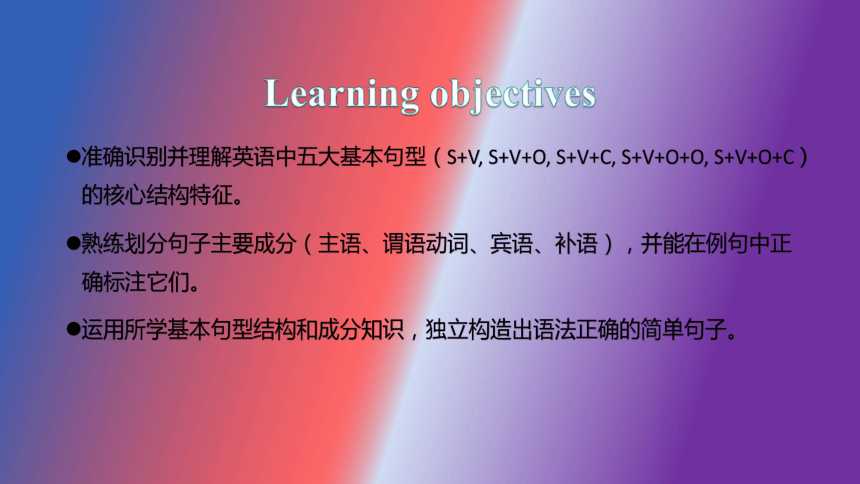

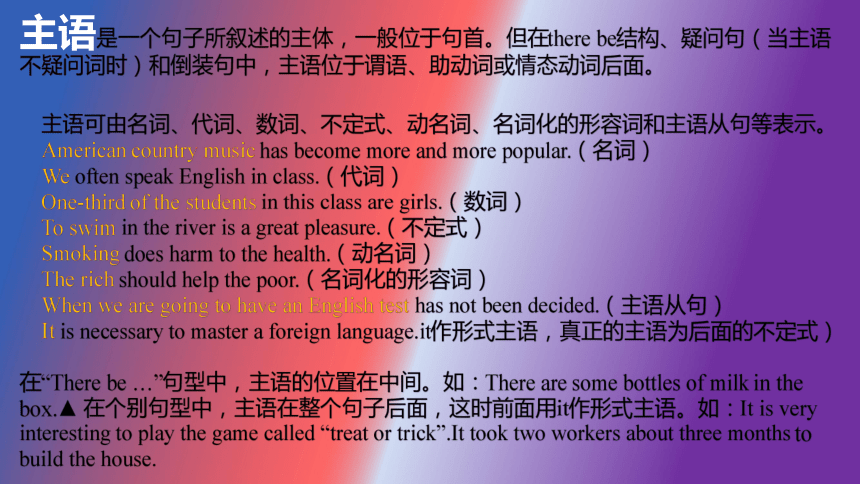
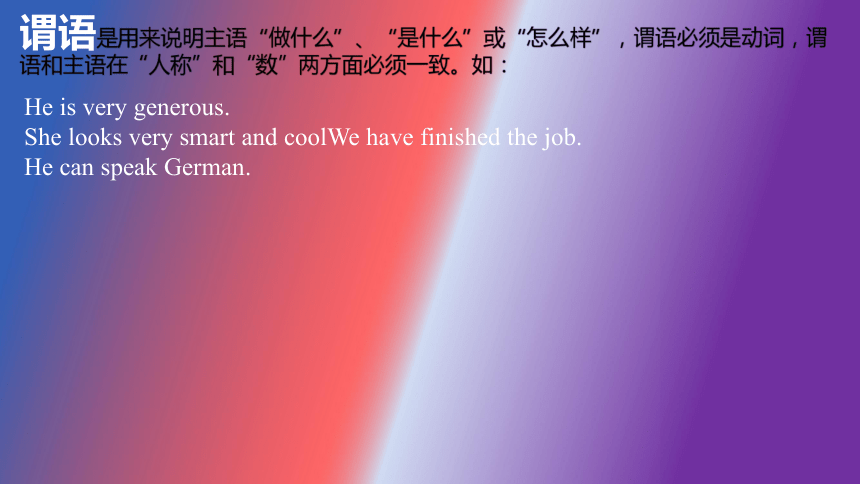
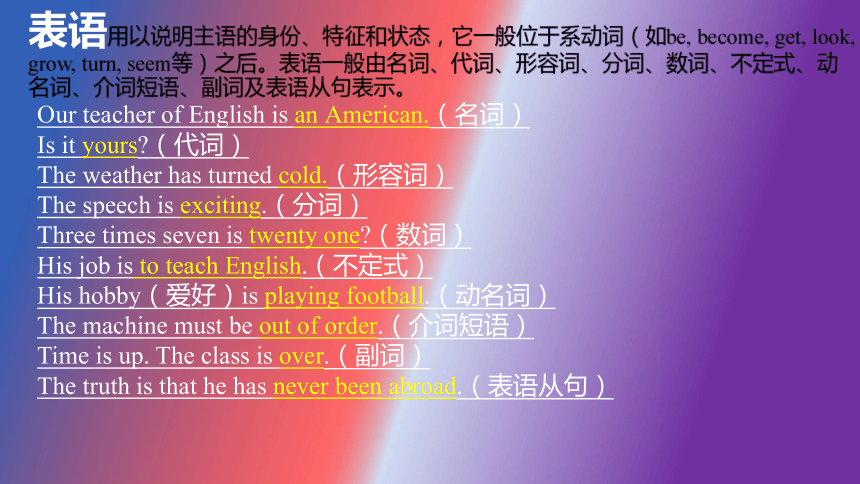
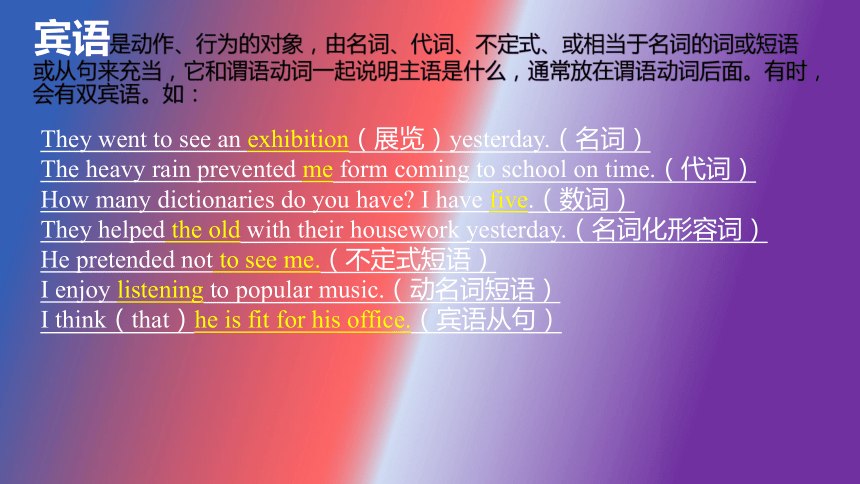
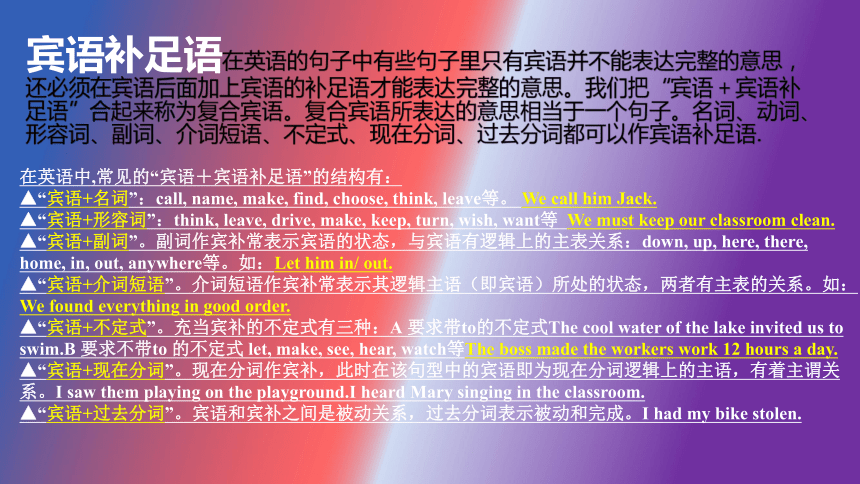
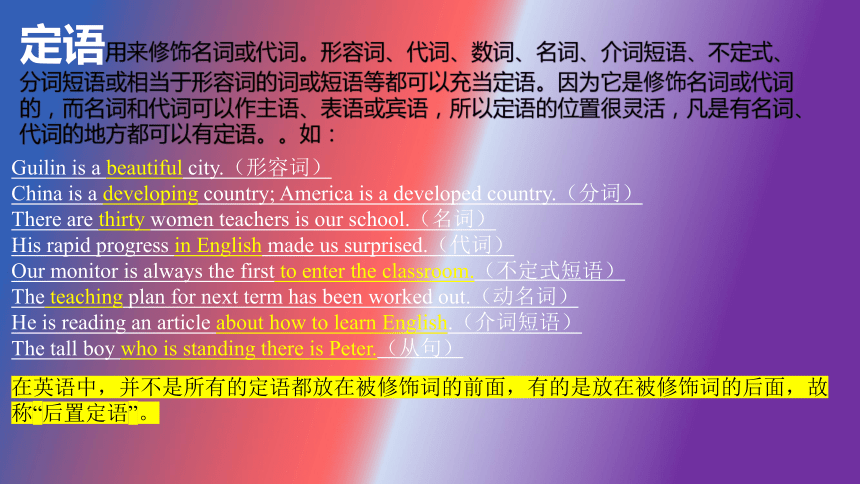
文档简介
(共20张PPT)
五大基本句型
Learning objectives
准确识别并理解英语中五大基本句型(S+V, S+V+O, S+V+C, S+V+O+O, S+V+O+C)的核心结构特征。
熟练划分句子主要成分(主语、谓语动词、宾语、补语),并能在例句中正确标注它们。
运用所学基本句型结构和成分知识,独立构造出语法正确的简单句子。
句子成分
构成句子的各个部分叫做句子成分。句子成分有主要成分和次要成分;主要成分有主语和谓语;次要成分有表语、宾语、定语、状语、补足语、同位语和插入语。
主语是一个句子所叙述的主体,一般位于句首。但在there be结构、疑问句(当主语不疑问词时)和倒装句中,主语位于谓语、助动词或情态动词后面。
主语可由名词、代词、数词、不定式、动名词、名词化的形容词和主语从句等表示。
American country music has become more and more popular.(名词)
We often speak English in class.(代词)
One-third of the students in this class are girls.(数词)
To swim in the river is a great pleasure.(不定式)
Smoking does harm to the health.(动名词)
The rich should help the poor.(名词化的形容词)
When we are going to have an English test has not been decided.(主语从句)
It is necessary to master a foreign language.it作形式主语,真正的主语为后面的不定式)
在“There be …”句型中,主语的位置在中间。如:There are some bottles of milk in the box.▲ 在个别句型中,主语在整个句子后面,这时前面用it作形式主语。如:It is very interesting to play the game called “treat or trick”.It took two workers about three months to build the house.
He is very generous.
She looks very smart and coolWe have finished the job.
He can speak German.
谓语是用来说明主语“做什么”、“是什么”或“怎么样”,谓语必须是动词,谓语和主语在“人称”和“数”两方面必须一致。如:
表语用以说明主语的身份、特征和状态,它一般位于系动词(如be, become, get, look, grow, turn, seem等)之后。表语一般由名词、代词、形容词、分词、数词、不定式、动名词、介词短语、副词及表语从句表示。
Our teacher of English is an American.(名词)
Is it yours (代词)
The weather has turned cold.(形容词)
The speech is exciting.(分词)
Three times seven is twenty one (数词)
His job is to teach English.(不定式)
His hobby(爱好)is playing football.(动名词)
The machine must be out of order.(介词短语)
Time is up. The class is over.(副词)
The truth is that he has never been abroad.(表语从句)
宾语是动作、行为的对象,由名词、代词、不定式、或相当于名词的词或短语或从句来充当,它和谓语动词一起说明主语是什么,通常放在谓语动词后面。有时,会有双宾语。如:
They went to see an exhibition(展览)yesterday.(名词)
The heavy rain prevented me form coming to school on time.(代词)
How many dictionaries do you have I have five.(数词)
They helped the old with their housework yesterday.(名词化形容词)
He pretended not to see me.(不定式短语)
I enjoy listening to popular music.(动名词短语)
I think(that)he is fit for his office.(宾语从句)
宾语补足语在英语的句子中有些句子里只有宾语并不能表达完整的意思,还必须在宾语后面加上宾语的补足语才能表达完整的意思。我们把“宾语+宾语补足语”合起来称为复合宾语。复合宾语所表达的意思相当于一个句子。名词、动词、形容词、副词、介词短语、不定式、现在分词、过去分词都可以作宾语补足语.
在英语中,常见的“宾语+宾语补足语”的结构有:
▲“宾语+名词”:call, name, make, find, choose, think, leave等。 We call him Jack.
▲“宾语+形容词”:think, leave, drive, make, keep, turn, wish, want等 We must keep our classroom clean.
▲“宾语+副词”。副词作宾补常表示宾语的状态,与宾语有逻辑上的主表关系:down, up, here, there, home, in, out, anywhere等。如:Let him in/ out.
▲“宾语+介词短语”。介词短语作宾补常表示其逻辑主语(即宾语)所处的状态,两者有主表的关系。如:We found everything in good order.
▲“宾语+不定式”。充当宾补的不定式有三种:A 要求带to的不定式The cool water of the lake invited us to swim.B 要求不带to 的不定式 let, make, see, hear, watch等The boss made the workers work 12 hours a day.
▲“宾语+现在分词”。现在分词作宾补,此时在该句型中的宾语即为现在分词逻辑上的主语,有着主谓关系。I saw them playing on the playground.I heard Mary singing in the classroom.
▲“宾语+过去分词”。宾语和宾补之间是被动关系,过去分词表示被动和完成。I had my bike stolen.
定语用来修饰名词或代词。形容词、代词、数词、名词、介词短语、不定式、分词短语或相当于形容词的词或短语等都可以充当定语。因为它是修饰名词或代词的,而名词和代词可以作主语、表语或宾语,所以定语的位置很灵活,凡是有名词、代词的地方都可以有定语。。如:
Guilin is a beautiful city.(形容词)
China is a developing country; America is a developed country.(分词)
There are thirty women teachers is our school.(名词)
His rapid progress in English made us surprised.(代词)
Our monitor is always the first to enter the classroom.(不定式短语)
The teaching plan for next term has been worked out.(动名词)
He is reading an article about how to learn English.(介词短语)
The tall boy who is standing there is Peter.(从句)
在英语中,并不是所有的定语都放在被修饰词的前面,有的是放在被修饰词的后面,故称“后置定语”。
状语用来修饰动词、形容词或副词。它表示行为发生的时间、地点、目的、方式、程度等,可用作状语的有副词、名词、代词、数词、形容词、不定式、分词、介词短语、从句等。
副词作状语: The boy needs a pen very much.
介词短语作状语:In the classroom, the boy needs a pen.
分词(短语)作状语:He sits there,asking for a pen.
不定式作状语:The boy needs a pen to do his homework.
名词作状语:Come this way! Wait a minute.
从句作状语:时间状语从句、地点状语从句、原因状语从句、结果状语从句、目的状语从句、比较状语从句、方式状语从句、让步状语从句、条件状语从句。如:It was raining when we arrived.
同位语:同位语是在名词或代词之后并列名词或代词对前者加以说明的成分,近乎于后置定语。We students should study hard. / (students是we的同位语,都是指同一批‘学生’)
同位语是在名词或代词之后并列名词或代词对前者加以说明的成分,近乎于后置定语。
We students should study hard. / (students是we的同位语,都是指同一批‘学生’)
We all are students. / (all是we的同位语,都指同样的‘我们’)
五大基本句子结构
Subject (主语) + Vi (谓语)
这种句型中的动词大多是不及物动词,所谓不及物动词,就是这种动词后不可以直接接宾语。常见的动词有:work, sing, swim, fish, jump, arrive, come, die, disappear, cry, happen等。如:
1) Li Ming works very hard.
2)Spring is coming.
补充:少数不及物动词后面能跟一个相同意义的名词作宾语这个名词和前面的动词在词根上是相同的或者在意义上是相近的这样的宾语就叫做同源宾语。常见的能带同源宾语的动词有lead, live, die, sleep, dream, breathe, smile, laugh, fight, run, sing等。如:
1) Under the leadership of the Party we lead a happy life.
2) I dreamed a terrible dream last night.
3) Our soldiers fought a wonderful fight against the floods last August.
4) He died a glorious death.
Subject (主语) + Link. V(系动词) + Predicate(表语)
这种句型主要用来表示主语的特点、身份等。系动词可分为6类:
状态系动词: 用来表示主语状态,只有be一词,
例: He is a teacher. (is与补足语一起说明主语的身份。)
持续系动词: 用来表示主语继续或保持一种状况或态度,主要有keep, remain, stay
例:This matter rests a mystery.
表像系动词: 用来表示"看起来像"这一概念,主要有seem, appear,look
例:He seems (to be) very sad.
变化系动词: 表示主语变成什么样,变化系动词主要有become, grow, turn, fall, get, go.
例: He became mad after that.
终止系动词: 表示主语已终止动作,主要有prove, turn out, 表达"证实","变成"之意,
例: The rumor proved false.
Subject(主语) + Vt(谓语) + Object (宾语)
这种句型中的动词一般为及物动词, 所谓及物动词,就是这种动词后可以直接接宾语,其宾语通常由名词、代词、动词不定式、动名词或从句等来充当。例:
1) He took his bag and left. (名词)
2) Li Lei always helps me when I have difficulties. (代词)
3) She plans to travel in the coming May Day. (不定式)
4) He managed to escape suffering from the disease. (动名词)
5) I don't know what I should do next. (从句)
注意:英语中的许多动词既是及物动词,又是不及物动词。如:start, answer, sing, close, consider, insist, read, learn, prepare, pay, hurt, improve, grow, beat, operate, smell, play, hang, ring, speak等。如:
Everybody, our game begins.
Let’s begin our game.
Subject (主语)+Vt (谓语)+ Indirect object (间接宾语)+Direct object (直接宾语)
这种句型中,直接宾语为主要宾语,表示动作是对谁做的或为谁做的,在句中不可或缺,常常由表示“物”的名词来充当;间接宾语也被称之为第二宾语,去掉之后,对整个句子的影响不大,多由指“人”的名词或代词承担。如:
Her father bought her a dictionary as a birthday present.
The old man always tells the children stories about the heroes in the Long March.
常见能跟双宾语的动词:award,bring,hand,lend,offer,pass等
Subject (主语)+Vt (动词)+Object (宾语)+Complement (补语)
这种句型中的“宾语 + 补语”统称为“复合宾语”。宾语补足语的主要作用或者是补充、说明宾语的特点、身份等;或者表示让宾语去完成的动作等。担任补语的常常是名词、形容词、副词、介词短语、分词、动词不定式等。如:
1) You should keep the room clean and tidy. (形容词)
2) We made him our monitor. (名词)
3) His father told him not to play in the street. (不定式)
4) My father likes to watch the boys playing basketball. (现在分词)
5) Yesterday I had a picture taken with two Americans. (过去分词)
6) We went to her house but found her out. (副词)
7) I found him in trouble. (介词短语)
● 常见跟动词不定式作宾补的动词有: tell, ask, advise, help, want, would like, order, force, allow等。
● 注意:动词have, make, let, see, hear, notice, feel, watch等后面所接的动词不定式作宾补时,不带to。如:
1) The boss made him do the work all day.
2) I heard her sing in the next room all the time last night.
一、指出下列句子的基本类型
1.Plants need water and sun.
2.The flowers are so fresh and beautiful.
3.The sun rises in the east.
4.He gave me some flowers.
5.We should keep the classroom clean and tidy.
6.Many animals live in trees.
7.Her mother looks very young.
8.She teaches us English.
9.The children are jumping and laughing happily.
10.Our teacher asked us to talk about thequestions in pairs.
11. He often tells me some interesting stories.
12.The students must keep their eyes closed.
二,指出下列句子中划线部分的成分。
1.Jack and Tom are doing their homework now.
2.Betty planted many trees and flowers on her farm
3.The boy under the tree is a policeman.
4.We went on a visit to the GreatWall last week
5.Yangjing was my best friend in my childhood.
6.He always walks in the park after supper with his wife.
7.Mary asked me to help her yesterday.
8.I bought my girlfriend a gold ring on her birthday.
9.Mr. Wei remains a doctor.
10.The boys and girls seemed excited when they heard the news.
Thank you.
五大基本句型
Learning objectives
准确识别并理解英语中五大基本句型(S+V, S+V+O, S+V+C, S+V+O+O, S+V+O+C)的核心结构特征。
熟练划分句子主要成分(主语、谓语动词、宾语、补语),并能在例句中正确标注它们。
运用所学基本句型结构和成分知识,独立构造出语法正确的简单句子。
句子成分
构成句子的各个部分叫做句子成分。句子成分有主要成分和次要成分;主要成分有主语和谓语;次要成分有表语、宾语、定语、状语、补足语、同位语和插入语。
主语是一个句子所叙述的主体,一般位于句首。但在there be结构、疑问句(当主语不疑问词时)和倒装句中,主语位于谓语、助动词或情态动词后面。
主语可由名词、代词、数词、不定式、动名词、名词化的形容词和主语从句等表示。
American country music has become more and more popular.(名词)
We often speak English in class.(代词)
One-third of the students in this class are girls.(数词)
To swim in the river is a great pleasure.(不定式)
Smoking does harm to the health.(动名词)
The rich should help the poor.(名词化的形容词)
When we are going to have an English test has not been decided.(主语从句)
It is necessary to master a foreign language.it作形式主语,真正的主语为后面的不定式)
在“There be …”句型中,主语的位置在中间。如:There are some bottles of milk in the box.▲ 在个别句型中,主语在整个句子后面,这时前面用it作形式主语。如:It is very interesting to play the game called “treat or trick”.It took two workers about three months to build the house.
He is very generous.
She looks very smart and coolWe have finished the job.
He can speak German.
谓语是用来说明主语“做什么”、“是什么”或“怎么样”,谓语必须是动词,谓语和主语在“人称”和“数”两方面必须一致。如:
表语用以说明主语的身份、特征和状态,它一般位于系动词(如be, become, get, look, grow, turn, seem等)之后。表语一般由名词、代词、形容词、分词、数词、不定式、动名词、介词短语、副词及表语从句表示。
Our teacher of English is an American.(名词)
Is it yours (代词)
The weather has turned cold.(形容词)
The speech is exciting.(分词)
Three times seven is twenty one (数词)
His job is to teach English.(不定式)
His hobby(爱好)is playing football.(动名词)
The machine must be out of order.(介词短语)
Time is up. The class is over.(副词)
The truth is that he has never been abroad.(表语从句)
宾语是动作、行为的对象,由名词、代词、不定式、或相当于名词的词或短语或从句来充当,它和谓语动词一起说明主语是什么,通常放在谓语动词后面。有时,会有双宾语。如:
They went to see an exhibition(展览)yesterday.(名词)
The heavy rain prevented me form coming to school on time.(代词)
How many dictionaries do you have I have five.(数词)
They helped the old with their housework yesterday.(名词化形容词)
He pretended not to see me.(不定式短语)
I enjoy listening to popular music.(动名词短语)
I think(that)he is fit for his office.(宾语从句)
宾语补足语在英语的句子中有些句子里只有宾语并不能表达完整的意思,还必须在宾语后面加上宾语的补足语才能表达完整的意思。我们把“宾语+宾语补足语”合起来称为复合宾语。复合宾语所表达的意思相当于一个句子。名词、动词、形容词、副词、介词短语、不定式、现在分词、过去分词都可以作宾语补足语.
在英语中,常见的“宾语+宾语补足语”的结构有:
▲“宾语+名词”:call, name, make, find, choose, think, leave等。 We call him Jack.
▲“宾语+形容词”:think, leave, drive, make, keep, turn, wish, want等 We must keep our classroom clean.
▲“宾语+副词”。副词作宾补常表示宾语的状态,与宾语有逻辑上的主表关系:down, up, here, there, home, in, out, anywhere等。如:Let him in/ out.
▲“宾语+介词短语”。介词短语作宾补常表示其逻辑主语(即宾语)所处的状态,两者有主表的关系。如:We found everything in good order.
▲“宾语+不定式”。充当宾补的不定式有三种:A 要求带to的不定式The cool water of the lake invited us to swim.B 要求不带to 的不定式 let, make, see, hear, watch等The boss made the workers work 12 hours a day.
▲“宾语+现在分词”。现在分词作宾补,此时在该句型中的宾语即为现在分词逻辑上的主语,有着主谓关系。I saw them playing on the playground.I heard Mary singing in the classroom.
▲“宾语+过去分词”。宾语和宾补之间是被动关系,过去分词表示被动和完成。I had my bike stolen.
定语用来修饰名词或代词。形容词、代词、数词、名词、介词短语、不定式、分词短语或相当于形容词的词或短语等都可以充当定语。因为它是修饰名词或代词的,而名词和代词可以作主语、表语或宾语,所以定语的位置很灵活,凡是有名词、代词的地方都可以有定语。。如:
Guilin is a beautiful city.(形容词)
China is a developing country; America is a developed country.(分词)
There are thirty women teachers is our school.(名词)
His rapid progress in English made us surprised.(代词)
Our monitor is always the first to enter the classroom.(不定式短语)
The teaching plan for next term has been worked out.(动名词)
He is reading an article about how to learn English.(介词短语)
The tall boy who is standing there is Peter.(从句)
在英语中,并不是所有的定语都放在被修饰词的前面,有的是放在被修饰词的后面,故称“后置定语”。
状语用来修饰动词、形容词或副词。它表示行为发生的时间、地点、目的、方式、程度等,可用作状语的有副词、名词、代词、数词、形容词、不定式、分词、介词短语、从句等。
副词作状语: The boy needs a pen very much.
介词短语作状语:In the classroom, the boy needs a pen.
分词(短语)作状语:He sits there,asking for a pen.
不定式作状语:The boy needs a pen to do his homework.
名词作状语:Come this way! Wait a minute.
从句作状语:时间状语从句、地点状语从句、原因状语从句、结果状语从句、目的状语从句、比较状语从句、方式状语从句、让步状语从句、条件状语从句。如:It was raining when we arrived.
同位语:同位语是在名词或代词之后并列名词或代词对前者加以说明的成分,近乎于后置定语。We students should study hard. / (students是we的同位语,都是指同一批‘学生’)
同位语是在名词或代词之后并列名词或代词对前者加以说明的成分,近乎于后置定语。
We students should study hard. / (students是we的同位语,都是指同一批‘学生’)
We all are students. / (all是we的同位语,都指同样的‘我们’)
五大基本句子结构
Subject (主语) + Vi (谓语)
这种句型中的动词大多是不及物动词,所谓不及物动词,就是这种动词后不可以直接接宾语。常见的动词有:work, sing, swim, fish, jump, arrive, come, die, disappear, cry, happen等。如:
1) Li Ming works very hard.
2)Spring is coming.
补充:少数不及物动词后面能跟一个相同意义的名词作宾语这个名词和前面的动词在词根上是相同的或者在意义上是相近的这样的宾语就叫做同源宾语。常见的能带同源宾语的动词有lead, live, die, sleep, dream, breathe, smile, laugh, fight, run, sing等。如:
1) Under the leadership of the Party we lead a happy life.
2) I dreamed a terrible dream last night.
3) Our soldiers fought a wonderful fight against the floods last August.
4) He died a glorious death.
Subject (主语) + Link. V(系动词) + Predicate(表语)
这种句型主要用来表示主语的特点、身份等。系动词可分为6类:
状态系动词: 用来表示主语状态,只有be一词,
例: He is a teacher. (is与补足语一起说明主语的身份。)
持续系动词: 用来表示主语继续或保持一种状况或态度,主要有keep, remain, stay
例:This matter rests a mystery.
表像系动词: 用来表示"看起来像"这一概念,主要有seem, appear,look
例:He seems (to be) very sad.
变化系动词: 表示主语变成什么样,变化系动词主要有become, grow, turn, fall, get, go.
例: He became mad after that.
终止系动词: 表示主语已终止动作,主要有prove, turn out, 表达"证实","变成"之意,
例: The rumor proved false.
Subject(主语) + Vt(谓语) + Object (宾语)
这种句型中的动词一般为及物动词, 所谓及物动词,就是这种动词后可以直接接宾语,其宾语通常由名词、代词、动词不定式、动名词或从句等来充当。例:
1) He took his bag and left. (名词)
2) Li Lei always helps me when I have difficulties. (代词)
3) She plans to travel in the coming May Day. (不定式)
4) He managed to escape suffering from the disease. (动名词)
5) I don't know what I should do next. (从句)
注意:英语中的许多动词既是及物动词,又是不及物动词。如:start, answer, sing, close, consider, insist, read, learn, prepare, pay, hurt, improve, grow, beat, operate, smell, play, hang, ring, speak等。如:
Everybody, our game begins.
Let’s begin our game.
Subject (主语)+Vt (谓语)+ Indirect object (间接宾语)+Direct object (直接宾语)
这种句型中,直接宾语为主要宾语,表示动作是对谁做的或为谁做的,在句中不可或缺,常常由表示“物”的名词来充当;间接宾语也被称之为第二宾语,去掉之后,对整个句子的影响不大,多由指“人”的名词或代词承担。如:
Her father bought her a dictionary as a birthday present.
The old man always tells the children stories about the heroes in the Long March.
常见能跟双宾语的动词:award,bring,hand,lend,offer,pass等
Subject (主语)+Vt (动词)+Object (宾语)+Complement (补语)
这种句型中的“宾语 + 补语”统称为“复合宾语”。宾语补足语的主要作用或者是补充、说明宾语的特点、身份等;或者表示让宾语去完成的动作等。担任补语的常常是名词、形容词、副词、介词短语、分词、动词不定式等。如:
1) You should keep the room clean and tidy. (形容词)
2) We made him our monitor. (名词)
3) His father told him not to play in the street. (不定式)
4) My father likes to watch the boys playing basketball. (现在分词)
5) Yesterday I had a picture taken with two Americans. (过去分词)
6) We went to her house but found her out. (副词)
7) I found him in trouble. (介词短语)
● 常见跟动词不定式作宾补的动词有: tell, ask, advise, help, want, would like, order, force, allow等。
● 注意:动词have, make, let, see, hear, notice, feel, watch等后面所接的动词不定式作宾补时,不带to。如:
1) The boss made him do the work all day.
2) I heard her sing in the next room all the time last night.
一、指出下列句子的基本类型
1.Plants need water and sun.
2.The flowers are so fresh and beautiful.
3.The sun rises in the east.
4.He gave me some flowers.
5.We should keep the classroom clean and tidy.
6.Many animals live in trees.
7.Her mother looks very young.
8.She teaches us English.
9.The children are jumping and laughing happily.
10.Our teacher asked us to talk about thequestions in pairs.
11. He often tells me some interesting stories.
12.The students must keep their eyes closed.
二,指出下列句子中划线部分的成分。
1.Jack and Tom are doing their homework now.
2.Betty planted many trees and flowers on her farm
3.The boy under the tree is a policeman.
4.We went on a visit to the GreatWall last week
5.Yangjing was my best friend in my childhood.
6.He always walks in the park after supper with his wife.
7.Mary asked me to help her yesterday.
8.I bought my girlfriend a gold ring on her birthday.
9.Mr. Wei remains a doctor.
10.The boys and girls seemed excited when they heard the news.
Thank you.
